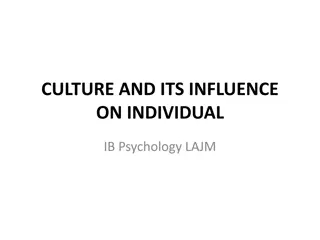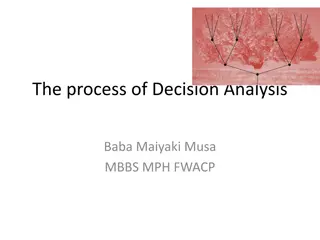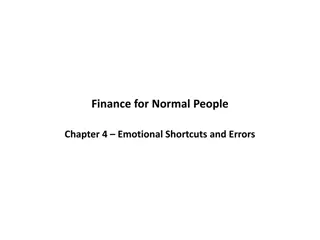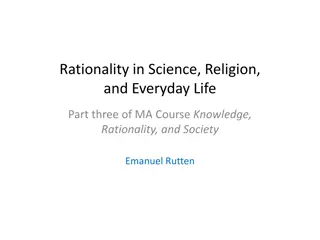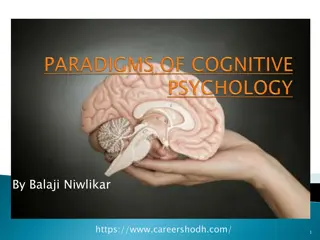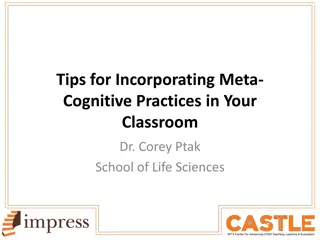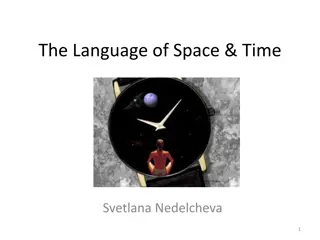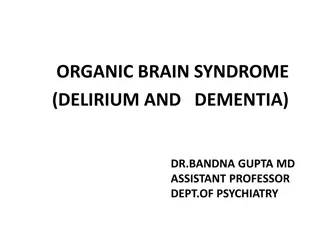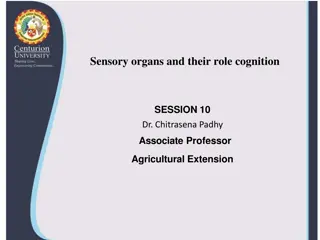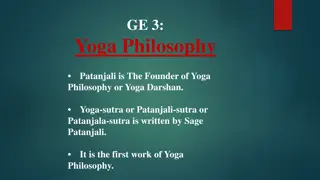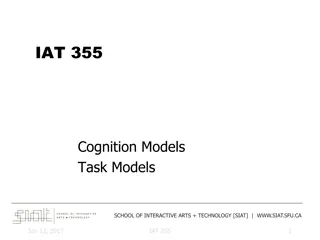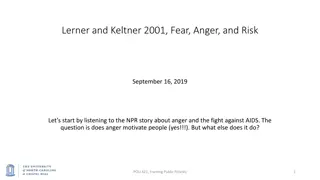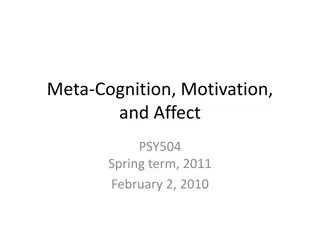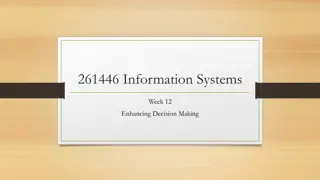Understanding Cognition and Decision Making
Cognition encompasses mental activities like thinking, knowing, and remembering, while concepts simplify thinking by grouping similar objects. Cognitive strategies and obstacles in problem-solving, such as algorithms and confirmation bias, also play a crucial role. The "Aha!" moment reflects sudden insight, and intuition impacts decision-making through heuristics like availability bias. Additionally, factors like fear of unlikely events influence our judgments.
Download Presentation

Please find below an Image/Link to download the presentation.
The content on the website is provided AS IS for your information and personal use only. It may not be sold, licensed, or shared on other websites without obtaining consent from the author. Download presentation by click this link. If you encounter any issues during the download, it is possible that the publisher has removed the file from their server.
E N D
Presentation Transcript
Module 25 Thinking Josef F. Steufer/Getty Images
Thinking Concepts 25-1: WHAT IS COGNITION, AND WHAT ARE THE FUNCTIONS OF CONCEPTS? Cognition: All the mental activities associated with thinking, knowing, remembering, and communicating. Concepts help to simplify thinking through mental grouping of similar objects, events, ideas, or people. After placing an item in a category, memory gradually shifts it toward a category prototype. Categoriesboundaries begin to blur as movement away from prototypes occurs.
Thinking Problem Solving: Strategies and Obstacles 25-2: WHAT COGNITIVE STRATEGIES ASSIST OUR PROBLEM SOLVING, AND WHAT OBSTACLES HINDER IT? An algorithm is a methodical, logical rule or procedure that guarantees a solution to a problem. A heuristic is a simpler strategy that is usually speedier than an algorithm but is also more error prone. Insight is not a strategy-based solution, but rather a sudden flash of inspiration that solves a problem.
Thinking Problem Solving: Strategies and Obstacles Once we incorrectly represent a problem, it s hard to restructure how we approach it. Confirmation bias predisposes us to verify rather than challenge our preconceptions. Fixation, such as mental set, may prevent us from taking the fresh perspective that would lead to a solution.
Thinking THE Aha! MOMENT A burst of right temporal lobe activity (yellow area) accompanied insight solutions to word problems (Jung-Beeman et al., 2004). The red dots show placement of the EEG electrodes. The light gray lines show patterns of brain activity during insight. The insight-related activity is centered in the right temporal lobe (yellow area).
Thinking Forming Good and Bad Decisions and Judgments 25-3: WHAT IS INTUITION, AND HOW CAN THE AVAILABILITY HEURISTIC, OVERCONFIDENCE, BELIEF PERSEVERENCE, AND FRAMING INFLUENCE OUR DECISIONS AND JUDGMENTS? Intuition is an effortless, immediate, automatic feeling or thought, as contrasted with explicit, conscious reasoning. Availability heuristics can distort judgment by estimating event likelihood based on memory availability. We reason emotionally and neglect probabilities We overfeel and underthink.
Thinking THE FEAR FACTOR WHY WE FEAR THE WRONG THINGS 25-4: WHAT FACTORS CONTRIBUTE TO OUR FEAR OF UNLIKELY EVENTS? 1. We fear what our ancestral history has prepared us to fear. 2. We fear what we cannot control. 3. We fear what is immediate. 4. We fear what is most readily available in memory.
Thinking Forming Good and Bad Decisions and Judgments Overconfidence The tendency to overestimate the accuracy of our knowledge and judgment. Across various tasks, people overestimate their performance. Class assignments generally take about twice the number of days students predict they will. This planning fallacy also routinely occurs with construction projects, which often finish late and over budget. Belief Perseverance Belief perseverance occurs when we cling to beliefs and ignore evidence that proves these are wrong. To rein in belief perseverance, consider the opposite. Comprehensively imagining and really pondering the other side of an issue can help reduce biases.
Thinking Forming Good and Bad Decisions and Judgments The Effects of Framing Framing the way we present an issue sways our decisions and judgments. It can be a powerful took of persuasion. Carefully posed options can nudge people toward decisions that could benefit them or society as a whole. Can you think of any such decisions?
Thinking Forming Good and Bad Decisions and Judgments The Perils and Powers of Intuition 25-5: HOW DO SMART THINKERS USE INTUITION? Intuition is analysis frozen into habit. Intuition is implicit knowledge. Intuition is usually adaptive, enabling quick reactions. Learned associations surface as gut feelings. Intuition flows from unconscious processing. Complex decisions often benefit from letting our brain work on the problem without consciously thinking about it. The bottom line: Our two-track mind makes sweet harmony as smart, critical thinking listens to the creative whispers of our vast unseen mind and then evaluates evidence, tests conclusions, and plans for the future.
Thinking Thinking Creatively 25-6: WHAT IS CREATIVITY, AND WHAT FOSTERS IT? Creativity is the ability to produce novel and valuable ideas. It is supported by Aptitude (the ability to learn) Intelligence Working memory Aptitude tests such as the SAT, which demand a single correct answer, require convergent thinking. Creativity tests (How many uses can you think of for a brick?) require expansive divergent thinking.
Thinking Thinking Creatively Divergent thinking Expands the number of possible problem solutions; creative thinking that diverges in different directions Convergent thinking Narrows the available problem solutions to determine the single best solution
Thinking Thinking Creatively Robert Sternberg and his colleagues propose five components of creativity(Sternberg, 1988, 2003; Sternberg & Lubart, 1991, 1992): Expertise Imaginative thinking skills A venturesome personality Intrinsic motivation A creative environment Ideas to boost your own creativity: Develop your expertise Allow time for incubation, setting aside problems for a while when needed Allow the mind to roam freely, without distractions Experience other cultures and ways of thinking
Thinking Do Other Species Share Our Cognitive Skills? 25-7: WHAT DO WE KNOW ABOUT THINKING IN OTHER ANIMALS? Researchers make inferences about other species consciousness and intelligence based on behavior. Many other animals use concepts, numbers, and tools, and can transmit learning from one generation to the next. Some species also show insight, self-awareness, altruism, cooperation, empathy, group aggression, and grief.
Thinking Do Other Species Share Our Cognitive Skills? Using concepts and numbers Several species demonstrate ability to sort (even pigeons and bears). Displaying insight Humans are not the only species to display insight (chimpanzees and even crows ). Using tools and transmitting culture Various species have displayed creative tool use (e.g., forest-dwelling chimpanzees; elephants; humans).



